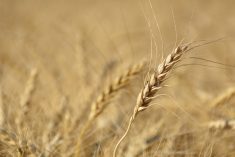Anyone who has watched pigs trot out of trucks into a slaughter house could easily reach the conclusion that all modern pigs are the same.
They are all about the same length. They are all the same shade of whitish-pink. And their faces are so similar they suggest that all pigs are formed in the image of the One Great Pig, all-powerful and omnipresent in the industry.
The similarity among slaughter hogs suggests that, unlike commercial cattle that come from a wide range of breeds, modern pigs have little of the wide-ranging genetic diversity of their forebears. The similarity among hogs also suggests there is little room in the industry for independent breeders like those in the cattle industry.
Read Also

Chinese offer complicates canola marketing
Recently the Chinese ambassador indicated that there would be a potential deal between Canada and China regarding the current tariff war.
But that would ignore the sea of genes swirling beneath the whitish-pink surface of the pig herd, said Ron James of the Canadian Swine Breeders Association.
And it would not recognize the key contribution independent swine breeders continue to make.
“You have to have the purebred blood in there,” said James, whose organization represents purebred swine breeders.
“If you crossbreed it down too much, you’re not getting the gain, you’re not getting the feed conversion.”
There are still purebred pig breeders throughout Canada. There aren’t as many as there were 10 years ago, but the ones still active are larger and play an equally large role, said James.
“We’re holding our own,” he said.
So are pig breeds. Though there are fewer purebred swine breeds than cattle breeds, genetic diversity is key to a pig producer’s success.
All slaughter hogs look virtually the same because they are a combination of the three major pig breeds: the Landrace, the Yorkshire and the Duroc.
Most commercial hog producers use a Yorkshire-Landrace mother bred to a Duroc sire. These two types of pig don’t look the same. The Duroc is a deep red, while the Yorkshire-Landrace is a whitish-pink.
But the inevitable result of breeding the two is white-skinned offspring. Since processors don’t like dark haired pigs (dark hair roots look unappetizing in bacon), producers rely on this three-breed combination to produce what the buyer wants.
Durocs are used as sires because they provide solid bone structure, leanness and aggression for the offspring. The Yorkshire-Landrace sow provides length and its calm demeanour makes for good mothering.
Lee Whittington of the Prairie Swine Centre said genetic diversity is alive and well in the hog industry, but may be a little disguised.
“Even though you don’t see spotted pigs or black hampshire hogs any more, the genetics from those fast-growing, lean animals are still in the breeds today,” said Whittington.
Hampshires were also commonly used as terminal sires for Yorkshire-Landrace sows, but since this combination is more likely to produce offspring with black hair roots, that breed has been in decline.
James said the pig breeding industry has concentrated on simplifying the breed mix and then improving genetics within the few main breeds.
“What we preach is keep it simple, use the best strength of those breeds,” said James.
“When a breed is large, there’s enough of a gene pool, there’s lots of choice for selective pressure.”
Breeding stock production in Western Canada is dominated by large private companies, such as PIC and Genex Swine Group, which provide commercial producers with mixed breed pigs from lines those companies have developed.
But independent purebred breeders still exist on the Prairies. As well, the large companies own nucleus herds from which they develop their lines.
In Ontario and Quebec, smaller, independent breeders play a larger role in the industry than in the West, said Whittington.
James said independent swine breeders have been thrown into the same rapid change the rest of the pig industry has endured for the past decade. Herd sizes have rapidly increased, while producer numbers have dropped.
Some swine breeders have survived by combining their herds with those of other producers and then operating as a single company.
Ten years ago, the swine breeders association had 200 members. Now there are 150. However, apart from most members having larger herds, some of the herds are local co-operatives, in which a number of smaller producers have banded together to form joint nucleus and multiplier herds.
James said this was necessary because producers need to be able to fill large breeding stock orders.
While the big pig breeding companies guard their genetic information, independent pig breeders use their information and the pedigrees of their animals as a selling point.
They register the breeding history and performance of the animals they have used, which helps buyers and breeders.
While the industry has concentrated on the three major breeds, breeders are still quick to respond to demand for other breeds.
For example, Maple Leaf Foods has found a market in Japan for Berkshire pigs, so a number of breeders have started to produce them.















